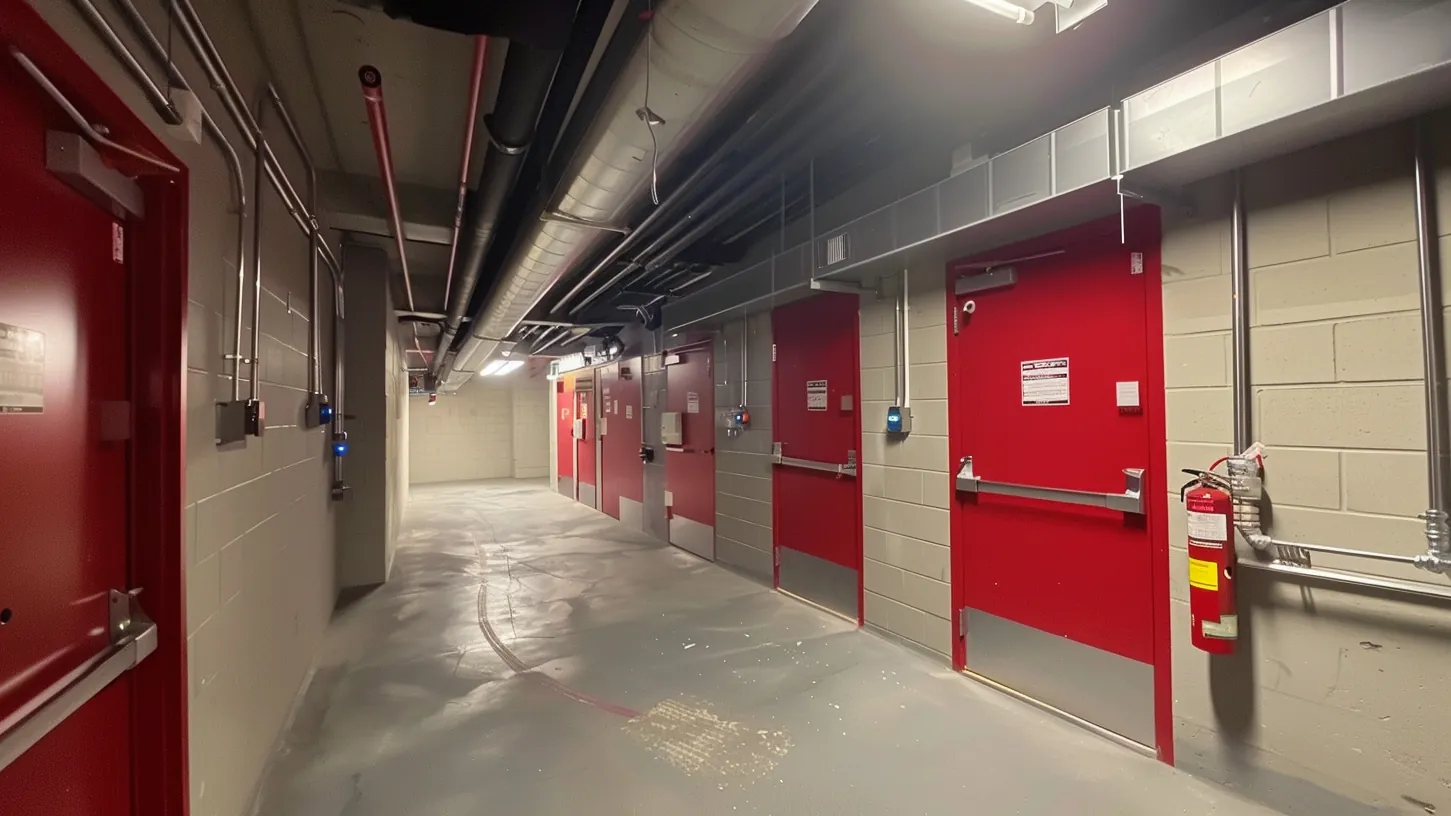What does a fire safety inspection consist of, and why it is a key element in maintaining the safety in your building? In our guide, we explain the most important steps to maintain best fire safety practices. We address legal compliance with fire safety regulations and provide a complete overview of the responsibilities and challenges of a fire safety inspection.
- Fire safety inspections are there to test and guarantee a high safety level of a building through compliance with legal fire safety obligations. Both structural and organizational measures have to be considered.
- Facilities management contributes significantly to the implementation and monitoring of fire protection measures by complying with legal regulations and carrying out appropriate maintenance and training procedures.
- Fire safety certificates, with specific requirements to all structural components and building materials used, are a central part of the building construction approval process and must be submitted and approved before start of construction.
The importance of fire safety inspections

Fire safety inspection is a key aspect in the construction and operation of every building. It includes a variety of measures aimed at preventing a fire from breaking out and minimizing the spreading of damage. Both structural and organizational measures must be accounted for and carried out to ensure the highest degree of safety.
Fire safety inspections play the main role here. Its goal is to ensure compliance with legal fire protection regulations and to test the safety of the building and its facilities. This includes both structural aspects, such as the design of escape routes and the creation of fire separation zones, and organizational aspects, such as staff training and the preparation of fire safety documentation.
The importance of fire safety inspections in facilities management
As part of facility management, facility managers play an important role in the implementation and monitoring of fire safety measures. They are responsible for ensuring that the legal requirements are met and carry out regular maintenance and fire safety inspections.
Fire safety laws and guidelines

In Germany, compliance with fire safety regulations must be verified for every construction project by submitting proof of compliance to the Model Building Code (MBO), which can vary, based on the state-specific building regulations and the height of the building. The requirements of the European Construction Products Regulation (BauPVO) must also be taken into account.
In addition to these legal requirements, there is an extensive amount of standards that regulate the allowed fire reaction of building materials and components, as well as technical specifications for fire-fighting systems and building assets. Compliance with these standards and guidelines ensure a very high level of fire safety.
Fire safety inspection liabilities
The main burden of responsibility for fire safety in buildings lies on the shoulders of the building owner, who is obliged to ensure structural fire safety. In addition, architects and civil engineers are also responsible for planning and implementing structural fire safety measures and, in case they are not certain, they can call in experts for an additional confirmation.
The technical aspects of fire safety are created by Technical building services planners and later implemented by specialized companies. In addition, external inspection experts can be commissioned by the client to document building inspections have been carried out to provide all safety measures for the finished building. However, it is the responsibility of the building inspectorate to ultimately approve the building’s acceptance. They are responsible for checking and approving compliance with fire safety regulations, so the assistance of a professional may be helpful in this step.
The facilities manager as fire safety inspector
As already mentioned, facilities managers make a great contribution to the implementation of fire safety inspection processes as well as building management and operations.
Their expertise in fire protection proves to be indispensable, not only in providing valuable expertise, but also in training staff – provided they are certified as specialist in fire safety.
The use of specialized software can play a central role here. With the Wowflow application, facilities managers can not only document their activities seamlessly, but also create and implement precise maintenance plans. The intuitive user interface makes it easy to plan, monitor and document all maintenance and inspection work.
The various types of fire safety certificates

Fire safety certificates are essential documents in the fire safety inspection process as they cover the many different aspects of this safety-related issue.
Being issued directly by fire safety inspectors, they document, among other things, the completeness and accuracy of fire safety certificates (fire protection certificate I) as well as the proper execution of construction work in accordance to fire protection regulations (certificate of fire protection II).
In this respect, a fire safety certificate is the single most important document for fire safety.
Fire safety certificate requirements
Fire safety certificates are an important part of fire safety measures, and therefore it must be tailored in strict accordance to the respective building class in question. The creation of a fire protection certificate must include the required parameters for all the building components and materials regarding their fire resistance and behaviour.
As a rule, the proof of fire safety must be submitted before planning permission is granted, showing that the building law regulations on fire safety have been met. Fire safety certificates are also part of the planning permission process during construction, modification and change of purpose of a building. They therefore must comply with the requirements specified by building laws and regulations.
Fire safety inspection checklist
A checklist can become helpful when carrying out a fire safety inspection, because it ensures that all the relevant aspects have been considered and no important procedures were overlooked. It can serve as a guide in the process, while helping to maintain an overview and structure to the entire fire safety inspection process.
Such a checklist could include items like checking fire safety certificates, testing fire safety equipment and inspecting escape and rescue routes. It should be updated regularly and adapted to individual usage circumstances.
You can find our checklists and templates for fire protection, maintenance and much more here.
Professional fire safety inspection software

Nowadays, technological solutions are playing an increasingly important role in fire safety. Modern software solutions can facilitate the fire safety inspection process and help to ensure compliance with regulations while documenting the safety measures which have been carried out. A solution like this could replace the complicated communication via email, WhatsApp and the like.
Wowflow offers a wide range of functions that make your everyday life easier:
- Digitally manage fire protection certificates
- Create checklists
- Track the progress of fire safety measures
- Maintain an overview of the various fire safety aspects
- Optimize the entire fire safety inspection process
4 tips for fire safety inspections
1. Adhere to the essential fire protection measures
- Avoidance of fire risks
- Regular maintenance and testing of equipment
- Fire extinguishers
- Fire alarm systems
- Fire brigade lifts
2. Ensure fire safety equipment maintenance
The availability of fire extinguishers and the training of fire safety assistants are essential components of company fire safety.
Regular maintenance and inspections can ensure that the SHEV systems or fire doors, for example, function in an emergency and thus contribute to safety in the building.
Cooperation with the fire protection department is of great importance for effective fire prevention.
3. Adapt your fire safety concept in the event of a change in utilization
Redesignations of buildings or parts of a building, including residential buildings, can have a significant impact on the fire safety concept and therefore require a reassessment of the fire safety measures.
Such utilization changes are, for example
- A loft conversion
- Changes to escape and rescue routes
- Changing the installation areas for fire department rescue equipment
4. Do not make any unauthorized modifications

Various problems can arise during a fire safety inspection. A frequent problem is unauthorized modifications to the building fabric, such as the replacement of waste water pipes or the routing of electrical cables without appropriate fire protection measures.
To counteract such risks, such changes must be reversed, or suitable fire protection measures must be implemented retrospectively. Close cooperation with fire protection experts plays a decisive role in solving such problems.
Summary
Fire safety inspection is an essential part of building management. It helps to minimize fire risks and ensure the safety of people and property.
A high level of fire safety can be achieved by complying with legal requirements, regularly maintaining and inspecting fire safety equipment and adapting the fire protection concept in the event of changes in utilization. Fire safety is an ongoing task that requires constant attention and commitment.
Use software for a clear overview of all fire safety related tasks.
Frequently asked questions
Which official standard documents the basic information on fire safety?
The fire safety regulations (Part A in accordance with DIN 14 096) describe basic information on fire safety measures. This regulates the behaviour of persons within a building in the event of a fire as well as fire prevention measures.
How often must a fire safety inspection be carried out?
Fire safety inspections should generally be carried out every week. A major fire safety inspection should also be carried out once a year. In areas working with high temperatures, daily inspections are recommended to ensure proper safety.
A thermal imaging camera can be used for support.
What is a fire safety inspection?
A fire safety inspection includes all fire safety checks and construction supervision to ensure that the building is safe for use.



